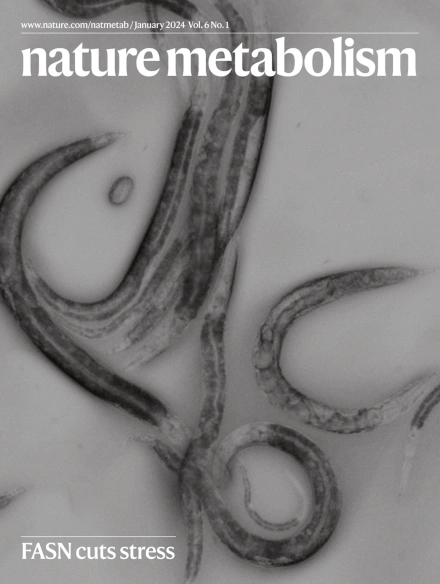母体运动通过SERPINA3C预防子代小鼠代谢紊乱
IF 18.9
1区 医学
Q1 ENDOCRINOLOGY & METABOLISM
引用次数: 0
摘要
母亲运动可以改善后代的代谢健康。然而,母体运动对后代有益影响的分子机制尚不清楚。本研究表明,妊娠期间的母体运动可减轻后代小鼠高脂肪饮食(HFD)诱导的脂肪炎症和葡萄糖耐受不良,并伴有母体脂肪组织和胎儿循环中脂肪因子丝氨酸蛋白酶抑制剂A3C (SERPINA3C)的上调。脂肪SERPINA3C敲低会损害,但其在哺乳动物中的过度表达模拟,母亲运动介导的代谢益处在hfd喂养的后代中。母体SERPINA3C被转运到胎儿循环中,促进胎儿前脂肪细胞中kr本文章由计算机程序翻译,如有差异,请以英文原文为准。


Maternal exercise prevents metabolic disorders in offspring mice through SERPINA3C
Maternal exercise can improve the metabolic health of the offspring. However, the molecular mechanisms underlying the beneficial effects of maternal exercise on the offspring remain unclear. Here, we show that maternal exercise during pregnancy alleviates high-fat diet (HFD)-induced adipose inflammation and glucose intolerance in offspring mice, accompanied by upregulation of the adipokine serine protease inhibitor A3C (SERPINA3C) both in maternal adipose tissues and the fetal circulation. Adipose SERPINA3C knockdown impairs, but its overexpression in dams mimics, maternal exercise-mediated metabolic benefits in HFD-fed offspring. Maternal SERPINA3C is transported into the fetal circulation and promotes Krüppel-like factor 4 (Klf4) gene promoter demethylation in fetal preadipocytes to increase KLF4 expression, which inhibits adipose inflammation in HFD-fed offspring mice. The SERPINA3C–cathepsin G–integrin β1 axis activates phosphatidylinositol 3-kinase signalling in preadipocytes. This promotes nuclear translocation of the p110β subunit to generate phosphatidylinositol 3,4,5-trisphosphate (PIP3) in the nucleus. O-linked β-N-acetylglucosamine (O-GlcNAc) transferase then binds to PIP3 to promote ten–eleven translocation methylcytosine dioxygenase 1 (TET1) O-GlcNAcylation, thereby enhancing TET1 activity to facilitate Klf4 gene promoter demethylation. These results provide mechanistic insights into maternal exercise-mediated improvement of offspring metabolism. Adipose-secreted SERPINA3C in exercised dams protects their offspring from high-fat diet-induced metabolic disorders by promoting KLF4-mediated anti-inflammatory effects in adipose tissue.
求助全文
通过发布文献求助,成功后即可免费获取论文全文。
去求助
来源期刊

Nature metabolism
ENDOCRINOLOGY & METABOLISM-
CiteScore
27.50
自引率
2.40%
发文量
170
期刊介绍:
Nature Metabolism is a peer-reviewed scientific journal that covers a broad range of topics in metabolism research. It aims to advance the understanding of metabolic and homeostatic processes at a cellular and physiological level. The journal publishes research from various fields, including fundamental cell biology, basic biomedical and translational research, and integrative physiology. It focuses on how cellular metabolism affects cellular function, the physiology and homeostasis of organs and tissues, and the regulation of organismal energy homeostasis. It also investigates the molecular pathophysiology of metabolic diseases such as diabetes and obesity, as well as their treatment. Nature Metabolism follows the standards of other Nature-branded journals, with a dedicated team of professional editors, rigorous peer-review process, high standards of copy-editing and production, swift publication, and editorial independence. The journal has a high impact factor, has a certain influence in the international area, and is deeply concerned and cited by the majority of scholars.
 求助内容:
求助内容: 应助结果提醒方式:
应助结果提醒方式:


